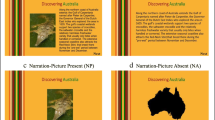Abstract
The present study aimed to provide evidence outlining whether the type of stimuli used in teaching would provoke differing levels of recall across three different academic age groups. One hundred and twenty-one participants, aged 11–25 years, were given a language-based memory task in the form of a wordlist consisting of 15 concrete and 15 abstract words, presented either visually, acoustically, or a combination of both audio and visual presentation. The study found that the presence of cognitive overload was greater in the older academic age participants than in the younger groups and that as academic experience increased, the visual presentation of the target stimuli produced greater levels of recall than was the case with acoustic and audio-visual presentation. Overall the findings indicate that cognitive overload increases with age, as the younger-age groups were found to have significantly higher levels of word recall in the audio-visual condition than the older groups.
Resumé
La présente étude visait à fournir des preuves indiquant que le type de stimuli utilisés dans l'enseignement provoquerait des niveaux différents de rappeler à travers trois différents groupes d'âge scolaire. 121 participants, âgés de 11–25 ans, ont eu une tâche de mémoire linguistique en fonction sous la forme d'un dictionnaire composé de 15 en béton et 15 mots abstraits, présenté soit visuellement, acoustiquement, ou une combinaison des deux audio et visuels de présentation. L'étude a révélé que la présence de surcharge cognitive était plus élevée chez les participants plus âgés universitaires que dans les groupes plus jeunes et que l'expérience universitaire a augmenté, la présentation visuelle des stimuli cibles produites niveaux plus élevés de rappeler que ce fut le cas acoustique et audio- présentation visuelle. Globalement, les résultats indiquent que les augmentations de surcharge cognitive avec l'âge, comme les groupes d'âge plus jeunes ont été trouvés à des niveaux significativement plus élevés de rappel de mots dans la condition audio-visuelle que les groupes plus âgés.

Similar content being viewed by others

References
Ahmed, C. (1998). Powerpoint versus traditional overheads. Which is more effective in learning? Paper presented at South Dakota Association for Health, Physical Education and Recreation, Sioux Falls, South Dakota, November 1998.
Cattell, R. B. (1963). Theory of fluid and crystallized intelligence: A critical experiment. Journal of Education & Psychology, 54, 1–22.
Chen, C. M., Lui, C. Y., & Chang, M. H. (2006). Personalized curriculum sequencing utilising modified item response theory for web-based instruction. Expert Systems with Applications, 30(2), 378–396.
Conway, C. M., & Christianson, M. H. (2005). Modality constrained statistical learning of tactile, visual, and auditory sequences. Journal of Experimental Psychology. Learning, Memory, and Cognition, 31(1), 24–39.
Craik, F. I. M., & Lockhart, R. S. (1972). Levels of processing: A framework for working memory research. Journal of Verbal Learning and Verbal Behaviour, 11, 67–84.
Diehl, R. L., Lotto, A. J., & Holt, L. L. (2003). Speech perception. Annual Review of Psychology, 55, 149–179.
Draper, S. W., & Brown, M. I. (2004). Increasing interactivity in lectures using an electronic voting system. Journal of Computer Assisted Learning, 20, 81–94.
Faul, F., Erdfelder, E., Lang, A.-G., & Buchner, A. (2007). G*Power 3: A flexible statistical power analysis program for the social, behavioral, and biomedical sciences. Behavior Research Methods, 39(2), 175–191.
Fowler, C. A. (1986). An event approach to the study of speech perception from a direct-realist perspective. Journal of Phoenetics, 14, 3–28.
Hirsh, I. J., & Watson, C. F. (1996). Auditory psychophysics and perception. Annual Review of Psychology, 47, 461–484.
Hoye, W., Dickinson, A., Banos, H., & Gierock, S. (2000). Executive functions and continuous visual memory test performance in a general neuropsychological sample. Archives of Clinical Neuropsychology, 15(8), 685–686.
Jiang, Y., & Leung, A. W. (2005). Implicit learning of ignored visual context. Psychonomic Bulletin & Review, 12(1), 100–106.
Kalyuga, S., Chandler, P., & Sweller, J. (2004). When redundant on-screen text in multimedia technical instruction can interfere with learning. Human Factors: The Journal of Human Factors and Ergonomics Society, 3, w567–w581.
Lechuga, M. T., Moreno, V., Pelegrina, S., Gomez-Ariza, C. J., & Bajo, M. T. (2006). Age differences in memory control: Evidence from updating and retrieval-practice tasks. Acta Psychologica, 123, 279–298.
Leech, G., Rayson, P., & Wilson, A. (2001). Word frequencies in written and spoken English: Based on the British National Corpus. London: Longman.
Liberman, A. M. (1996). Speech: A special code. Cambridge: MIT.
Moreno, R., & Mayer, R. E. (2001). A coherence effect in multimedia learning: The case for minimizing irrelevant sounds in the design of multimedia instructional messages. Journal of Education & Psychology, 93(1), 187–198.
Paivio, A., Yuille, J. C., & Madigan, S. A. (1968). Concreteness, imagery, and meaningfulness values for 925 nouns. Journal of Experimental Psychology, Monograph Supplement, 76(1), 1–25.
Papinikolaou, K. A., Grigoriadou, M., Magoulas, G. D., & Kornilakis, H. (2002). Towards new forms of knowledge communication: The adaptive dimension of a web-based learning environment. Computers & Education, 39(4), 333–360.
Ryan, M., Carlton, K. H., & Ali, N. S. (1999). Evaluation of traditional classroom teaching methods versus course delivery via the World Wide Web. The Journal of Nursing Education, 38(6), 272–277.
Saada-Robert, M. (1999). Effective means for learning to manage cognitive load in second grade school writing: A case study. Learning and Instruction, 9(2), 189–208.
Smith, H. J., Higgins, S., Wall, K., & Miller, J. (2005). Interactive whiteboards: Boon or bandwagon? A critical review of the literature. Journal of Computer Assisted Learning, 21(4), 91–104.
Sweller, J. (1988). Cognitive load during problem solving: Effects on learning. Cognitive Science, 12, 257–285.
Tindall-Ford, S., Chandler, P., & Sweller, J. (1997). When two sensory modes are better than one. Journal of Experimental Psychology, 3(4), 257–287.
Wall, K., Higgins, S., & Smith, H. (2005). ‘The visual helps me understand the complicated things’: Pupil views of teaching and learning with interactive whiteboards. British Journal of Educational Technology, 36(5), 851–867.
Author information
Authors and Affiliations
Corresponding author
Additional information
Jennifer Murray. Glasgow Caledonian University, Department of Psychology, 70 Cowcaddens Road, Glasgow, G4 0PP, Scotland, UK. E-mail: jennifer.murray@gcu.ac.uk
Mary Thomson. Glasgow Caledonian University, Department of Psychology, 70 Cowcaddens Road, Glasgow, G4 0PP, Scotland, UK. E-mail: m.thomson@gcu.ac.uk
Current themes of research:
Jennifer Murray’s current research interests focus primarily on examining judgemental bias in clinical judgements of violence risk assessment. She is also interested in the changes in memory across the lifespan, having previous research experience investigating the impact of glucose on prospective memory and eyewitness’ memory across older and younger adults.
Mary Thomson’s research focus is on all aspects of judgment and decision making. She has published in a wide variety of books and journals, including The Journal of Behavioural Decision Making, Risk Analysis, the International Journal of Forecasting, The European Journal of Operational Research and Decision Support Systems.
Most relevant publications in the field of Psychology of Education:
Murray, J., & Thomson, M. E. (2008). The effects of academic experience on the presence of cognitive overload in an audio-visual memory task. Proceedings of the BPS Cognitive Section Conference, p. 77.
Appendices
Appendix A
Word list used in the current research, shown in the order presented to participants: Flower, Anger, Corn, Truth, Shoes, Belief, Car, Effort, Apple, Theory, Bird, Moral, Fire, Knowledge, Table, Freedom, River, Chance, Heart, Mood, Radio, Fate, Window, Interest, Doctor, Idea, House, Hope, Rock, Honour.
Appendix B
Rights and permissions
About this article
Cite this article
Murray, J., Thomson, M.E. Age-related differences on cognitive overload in an audio-visual memory task. Eur J Psychol Educ 26, 129–141 (2011). https://doi.org/10.1007/s10212-010-0032-7
Received:
Revised:
Published:
Issue Date:
DOI: https://doi.org/10.1007/s10212-010-0032-7



